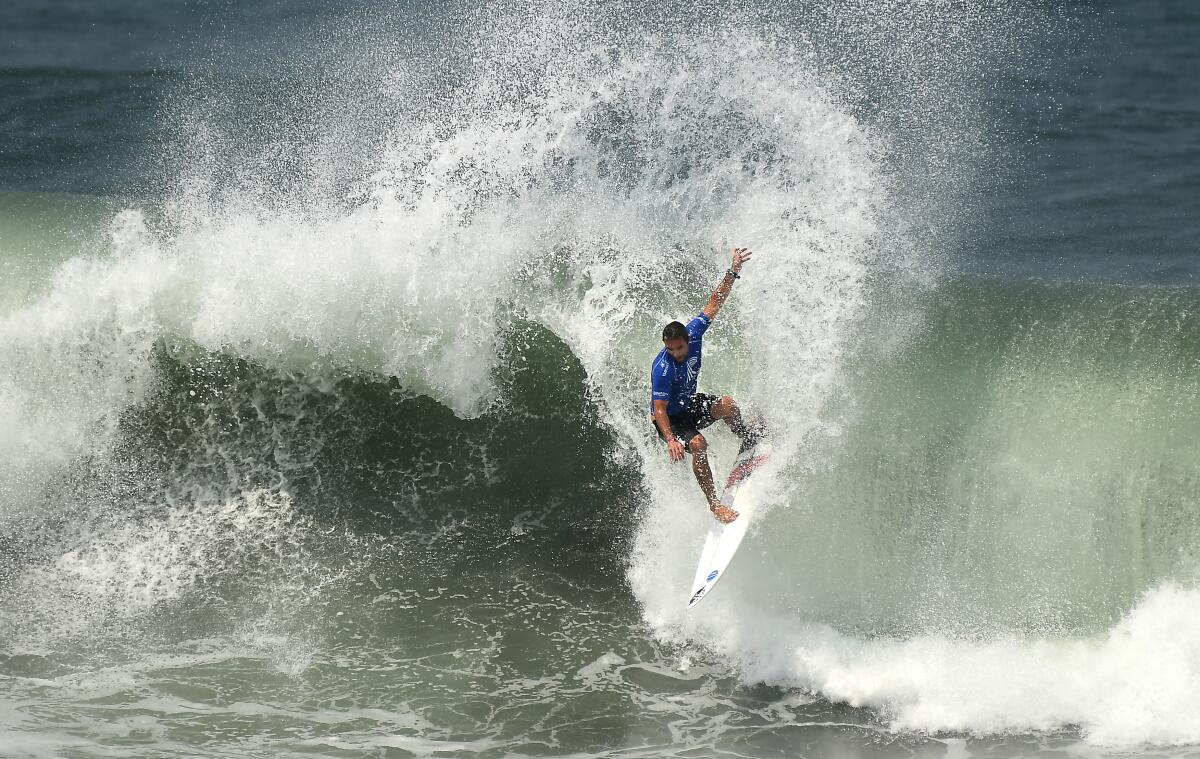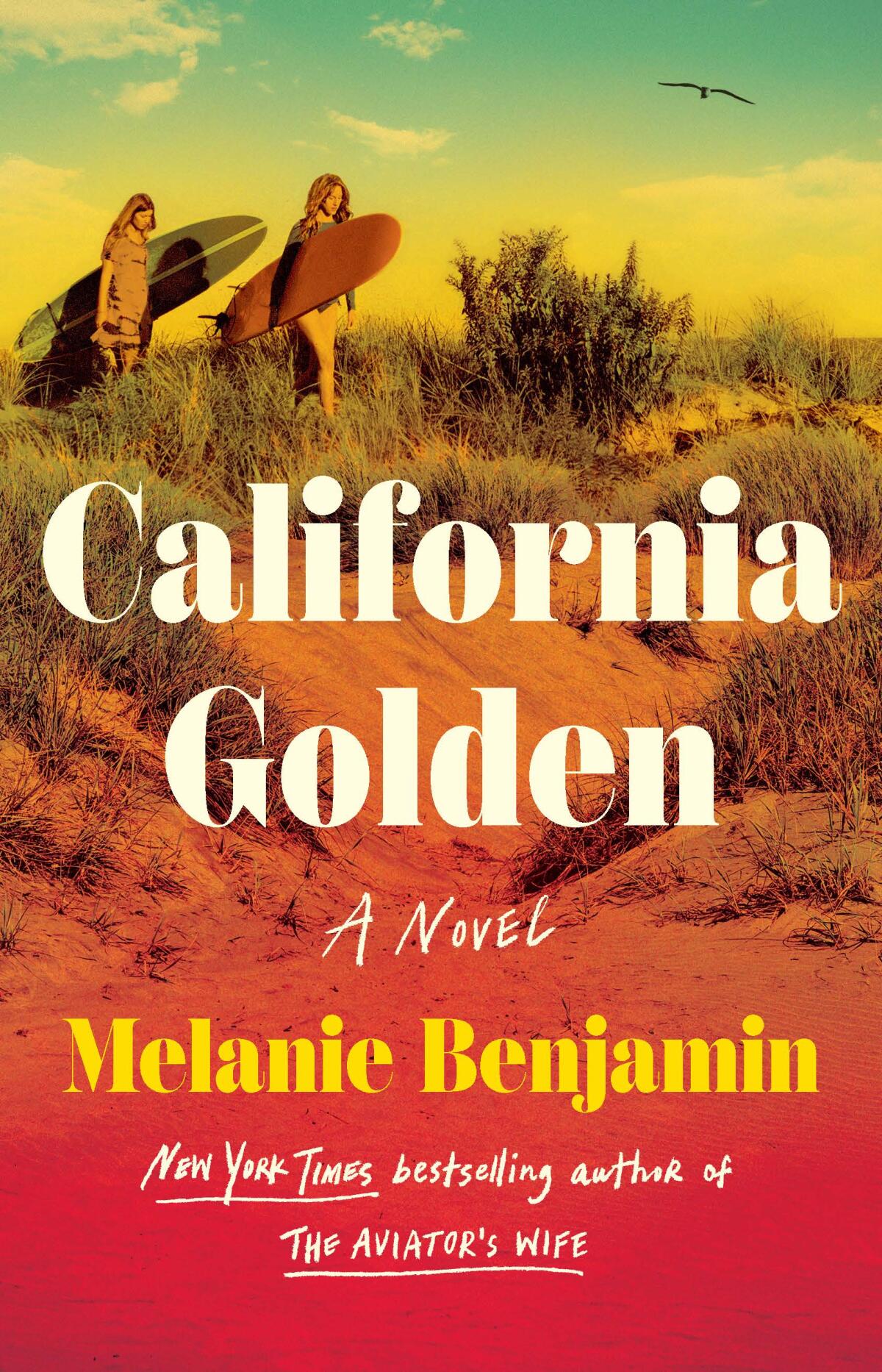A troubled SoCal surfing family rides the monster waves of history in new novel

- Share via
Review
California Golden
By Melanie Benjamin
Delacorte: 352 pages, $28
If you buy books linked on our site, The Times may earn a commission from Bookshop.org, whose fees support independent bookstores.
Every novel should teach you at least one thing. If you’re looking for a meticulously detailed breakdown of surf culture, look no further than Melanie Benjamin’s new novel “California Golden,” about a broken family of surfers and a national cult of beach life that flourished after World War II in Southern California.
Carol Donnelly and her 10-year-old Mindy and 8-year-old Ginger live a slipping-down kind of life, especially after her husband Bob abandons the girls to their alcoholic grandmother while Carol is off on an overlong surf holiday in Hawaii. In alternating chapters that form the first half of the book, Mindy and Ginger both recall dinners of baloney sandwiches, lunches of sandy PB&J and days spent wearing the same clothes because their mom had no time or energy for anything but surfing.
L.A.’s 16 essential works of literary fiction, from ‘The Day of the Locust’ to ‘If He Hollers Let Him Go,’ ‘Play it as it Lays’ to ‘Interior Chinatown.’
Mindy, who takes to a balsa Hobie as easily as Carol once did, has bigger plans. She responds to the call of Hollywood, becoming “the girl in the curl” for those early 1960s beach-blanket movies and a fixture of cool clubs like Whisky a Go Go. Benjamin, whose seven previous historical novels include stories about Manhattan socialites, Midwestern orphans and even “Alice in Wonderland,” slathers on the period detail as thickly as zinc oxide on a surfer’s nose. She even includes one of the weirder pockets of West Coast counterculture, a commune where Ginger winds up after her sister leaves home.

Mindy’s escape prevents her from realizing how deeply her sister, less gifted and needier, has fallen into the grasp of Tom Bailey. Tom, who refers to himself as “The Surf God” and eschews Mindy’s bourgeois crowd as “kooks,” convinces Ginger to camp in his sand-bound Quonset hut and steal food for him as he pursues dead-end schemes.
As those schemes fail and lead to darker crimes, Tom becomes abusive and controlling, ultimately dragging brainwashed Ginger to a cult in the hills above Laguna Beach, where Ginger is renamed Blissful, and Tom makes himself scarce. The plot’s ultimate catalyst, however, is Jimmy Cho, a Donnelly family friend who reenters the sisters’ lives when they’re in Hawaii for an important competition. Mindy wins that one, along with the admiration of Jimmy – whom she admires right back.
In ‘I Just Wanna Surf,’ Gabriella Angotti-Jones dives deep into the way in which the cyclical nature of trauma and healing mirrors chasing a wave.
Jimmy will play a part in both sisters’ futures, but his role illustrates some flaws in Benjamin’s overstuffed project. The author clearly wanted to write a book about California and its surf culture that would acknowledge the origins of surfing, its appropriators (good and bad) and its true believers (same). To do that, she needed to bring in at least one character of a different race. Jimmy winds up as a lonely avatar of diversity in a book stuffed with storylines.

Benjamin also wants us to understand Carol’s story on its own terms — separate from the damage she has inflicted. Pregnant and married by 19, faced with the long slog from diapers to lunchboxes to bridal dresses, she bolted to Hawaii in a last-ditch effort to hold onto her passions and her individuality. If Mindy and Ginger got caught up in the fads and rebellions of the ’60s, at least they had more options than their mother had in the ’40s.
That is, in part, what makes Ginger’s trajectory even tougher to stomach. She goes back to Tom again and again, even with other options available. “All I ever wanted was to be loved by someone. All I ever wanted was to be necessary,” she says at one point, and perhaps we are meant to understand that Carol’s wretched parenting has consequences. But it doesn’t quite work, any more than the plot’s occasional references to Carol’s fate — especially after early portents fizzle into anticlimax.
The characters spring to life, however, when they’re on their boards. Toes gripping carefully applied wax, arms loose and eyes forward, these surfing experts convey the joy and freedom that even the most casual boogie boarder feels in the ocean. There’s been some attention lately paid to so-called “art monsters,” especially as the phrase pertains to women who choose to prioritize creativity over time with their families. “California Golden” is a book about an athlete monster who pays a high price for her devotion to surfing — not because she rejects the patriarchy, but because desperation robs her of any sense of perspective.
‘Biography of X,’ Catherine Lacey’s fourth novel, tracks the hidden life of a late artist who left behind a trail of deceptions in an alternate-history U.S.
Desperation might seem like an odd undercurrent in a book teeming with sand, sun, water, hot-pink bikinis and hamburger stands. But this is Benjamin’s strength as an author of historical novels; she can make a deft collage out of Hollywood, a Vietnam MASH unit, ’60s rebellion and ’40s despair and even a glimmer of real hope for a better future.
But everyone’s greatest strength is also their greatest weakness. At times, this book feels crammed with subplot and passing references to developments, like the hookups between Carol and her best friend DeeDee, that might have been a bigger deal in that era. But in other places — and overall — “California Golden” plants its feet firmly on the board and rides a powerful wave of nostalgia, eyes focused on the opportunities and dangers ahead.
Patrick is a freelance critic, podcaster and author of the memoir “Life B.”
More to Read
Sign up for our Book Club newsletter
Get the latest news, events and more from the Los Angeles Times Book Club, and help us get L.A. reading and talking.
You may occasionally receive promotional content from the Los Angeles Times.









